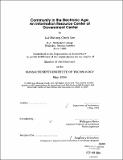Community in the electronic age : an information resource center at Government Center
Author(s)
Lee, Lai-Sheung Cindy
DownloadFull printable version (10.05Mb)
Other Contributors
Massachusetts Institute of Technology. Dept. of Architecture.
Advisor
Wellington Reiter.
Terms of use
Metadata
Show full item recordAbstract
In the wake of the exploding information and communication technology, this thesis explores the role of a civic architecture which restores on the one hand a traditional public institution, while on the other hand represents a functional information exchange in the Electronic Age. The proposed Information Resource Center is modeled after the positive social qualities inherent in the "third place". Utilizing the communicative ability of the available technology, the IRC supports the proposition of an intermediate realm, between the public and the private, which would restore community in our lives. This exploration begins with a look at Ray Oldenberg's analysis of the third place whose socially redeeming nature is beneficial to both the individual and to the collective. Such intermediate places have now been replaced by a new paradigm; the notion of cyberspace, a gathering place that is not rooted in space or time, has became popularized. Yet its accessible characteristics are still bounded by a structured social environment. Architecture's role then is to adapt and to accommodate while further defining a changing cultural landscape. In these times of rapid technological and social changes, people search for continuity and meaning in their surroundings . The design for the IRC addresses their need for community by providing them the resources to reach out to others virtually and as an intermediate place where an informal public life can be fostered.
Description
Thesis (M. Arch.)--Massachusetts Institute of Technology, Dept. of Architecture, 1994. Includes bibliographical references (leaf 67).
Date issued
1994Department
Massachusetts Institute of Technology. Department of ArchitecturePublisher
Massachusetts Institute of Technology
Keywords
Architecture.